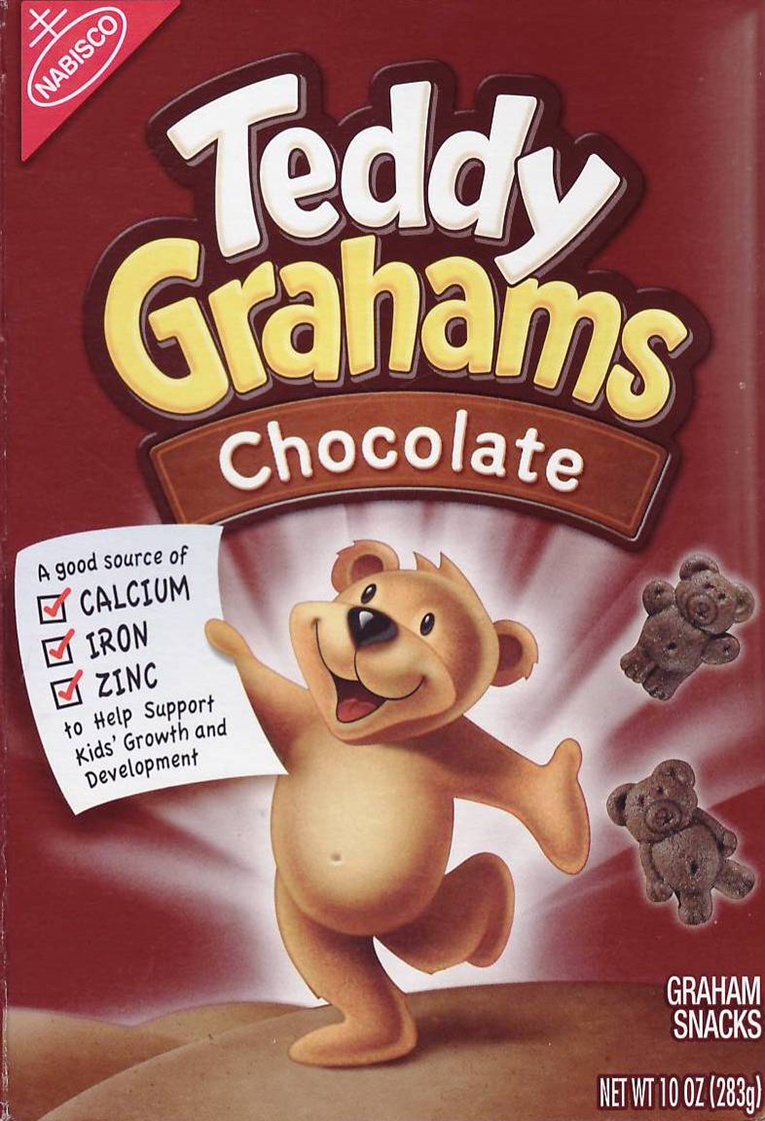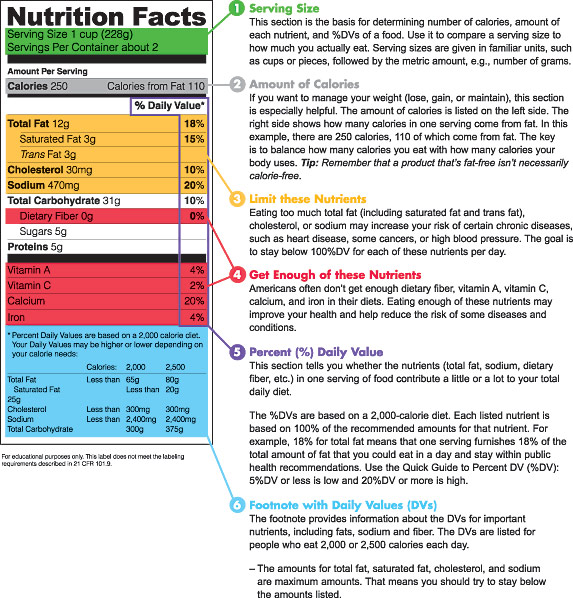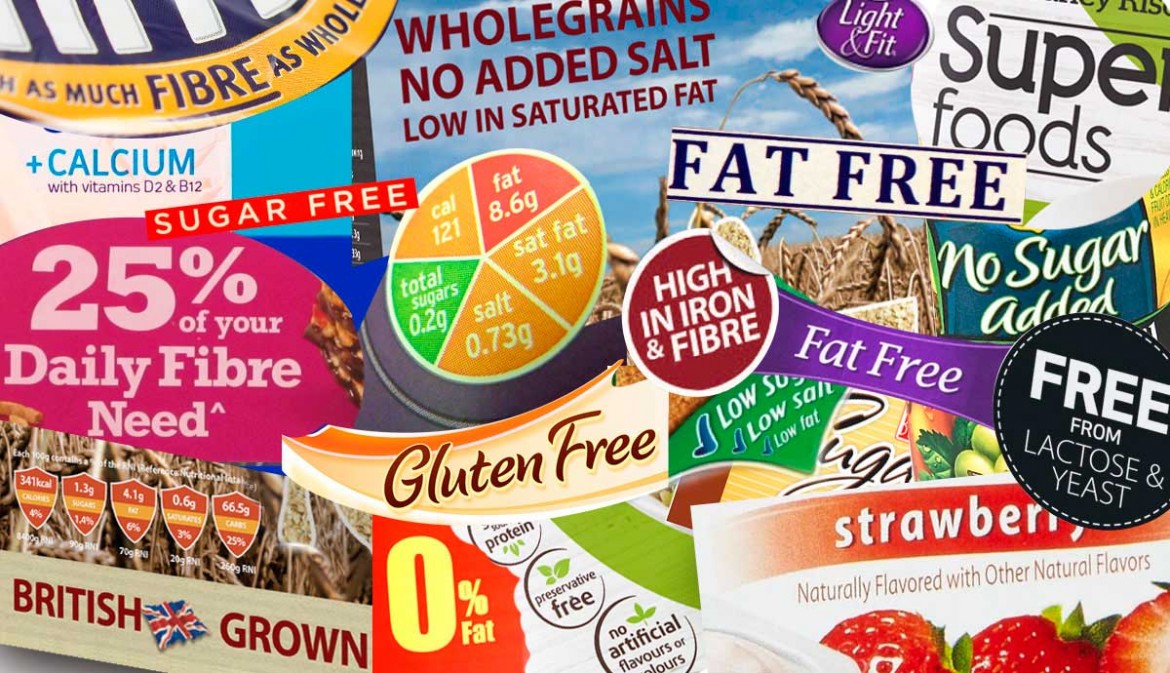44 examples of nutrient claims on food labels
Nutrition content claims and health claims For example: 'calcium for healthy bones and teeth'. These claims are either based on one of the more than 200 pre-approved food-health relationships in the Standard, or a food-health relationship self-substantiated by the food business using the scientific method set out in the Standard. Factual Food Labels: Health Claims - UT Austin 100% Online ... Health Claims. In 1990, the Nutrition Labeling and Education Act allowed claims that related a specific food component (e.g., oats) to lowered disease risk (e.g., reduced cholesterol) to be printed on the label of a food product. For example, if a company wants to place a health claim on their food packaging, such as "Heart Healthy," they ...
Nutrient Claims on Food Labels - Truly Good Foods Nutrient Claims on Food Labels July 19, 2018 Nutrient claims describe the content of a food, including the amount of nutrients, calories, cholesterol or fiber, but not in exact amounts. Usually on the front of the food label, the nutrient claim provides a quick comparison between similar products.
Examples of nutrient claims on food labels
Nutrition, health and related claims - Food Standards Food businesses wanting to make a general level health claim can base a claim on one of the more than 200 pre-approved food-health relationships in the Standard or self-substantiate a food-health relationship by following the process for systematic review in Schedule 6 of the Code. Self-substantiating a food-health relationship Food Label Claims: What You Can and Can't Trust For example, a label could say that getting enough calcium throughout your life, and having a balanced diet, may lower your chances of getting osteoporosis. Structure/function claims. These... Understanding Food Labels and Health Claims - Nutrition ... There are three levels of health claims: A health claim is supported by scientific evidence. An example is "reduces heart disease." A qualified claim has supportive evidence, which is NOT definitely proven with scientific evidence. There is evidence to SUGGEST a health benefit, but there is no scientific evidence.
Examples of nutrient claims on food labels. Nutrient Claims And Health Claims On Food Labels - Magoda ... Health claims examples may include things like stating that a product can cure or reverse a specific health condition or that a food item or supplement improves a health condition. If the FDA has not reviewed and cleared a food item or supplement to provide a factual health claim, supplement makers must inform the consumer. Factual Food Labels: Health Claims The terms that are used in this type of label is "free," "reduced," "high," and "low." These type of claims are only applicable to nutrients that have a % daily value established such as saturated fat, added sugars, and vitamins and minerals. An example of this type of claim is "low/less sugar." 7 Fake Claims On Food Nutrition Labels That Are Affecting ... Nutrition claim #2: Sugar-free. A lot of 'diet-friendly foods' proudly claim on their label that they contain no sugar and are still sweet or have 'great taste'. A closer look at their labels will show an addition of either honey or high fructose corn syrup, malt, dextrin or even sugar alcohols like maltitol or sorbitol. How Food Packaging Claims Can Fool You - Consumer Reports "Food manufacturers use every possible word they can to magnify the desirability of a product," says Walter Willett, M.D., professor of epidemiology and nutrition at the Harvard T.H. Chan ...
Health Claims on Food Labels - Consumer Reports R eading the information on food packaging—especially the nutrition facts panel and ingredients list—can help you make wiser choices. But some of the wording you see on the front of packages ... What are Nutrient Content Claims on food labels ... What are Nutrient Content Claims on food labels? Some examples of nutrient content claims are sugar-free, lean, light, and many other terms. Some Nutrient claims are about the content of certain nutrients and may state that the product is low in fat or a good source of calcium. Nutrient content claim examples - Nutrient content claims ... Nutrient content claim example - fibre claims Example - High source of fibre The following claim appears on a box of 6 muffins: "High source of wheat bran and oat bran". Each muffin contains 1.5 g of fibre from wheat bran and 3.5 g of fibre from oat bran per serving of stated size of 90 g. Understanding Food Labels - Nutrition: Science and ... Figure 1.13. Part of a nutrition fact label by Alice Callahan, CC BY 4.0, edited from "Nutrition Facts Label" by C.D.C. is in the Public Domain; Figure 1.14. "Soup label comparison" by U.S.D.A. ChooseMyPlate is in the Public Domain; Figure 1.15. "Examples of food packaging with nutrient claims" by Alice Callahan is licensed under CC ...
Food Labeling Claims Chart Food Nutritional Facts Guide ... Family nutrition article: nutrient content claims and facts article w/ printable nutrient claims facts chart. Food labeling information- Ever wonder what all the food label nutrient label claims really mean? What is the difference is between fat free, saturated fat free, low fat, lite, and reduced fat? Find out nutrient information and the facts about nutrient claims to make healthier food ... Nutrient function claims - Health claims on food labels ... For example, the nutrient function claim "Milk helps build strong bones and teeth" is unacceptable, because a nutrient function claim refers to the nutritional function of energy or a nutrient ( e.g., calcium) in a food, not a particular food ( e.g., milk). Nutrition claims - Canada.ca These claims are optional and may be found on some food products. Nutrient content claims describe the amount of a nutrient in a food. A good source of iron is an example of a nutrient content claim. Health claims are statements about the helpful effects of a certain food consumed within a healthy diet on a person's health. Label Claims for Conventional Foods and Dietary ... Examples include simple percentage statements such as "40% omega-3 fatty acids, 10 mg per capsule," and comparative percentage claims, e.g., "twice the omega-3 fatty acids per capsule (80 mg) as in...
Introduction to Food Product Claims — FDA Reader Examples of a Structure/Function Claim: "Calcium builds strong bones" "Fiber maintains bowel regularity" "Antioxidants maintain cell integrity" Conventional food producers do not need to notify the FDA about structure/function claims or make disclaimers associated with these claims on their product labels.
Decoding the Nutrition Label: Health Claims and Nutrient ... Below are examples of health claims you may find on some foods: A healthy diet rich in vegetables and fruit may help reduce the risk of some types of cancer. A healthy diet low in saturated and trans fat may reduce the risk of heart disease.
Label Claims for Food & Dietary Supplements | FDA Types of Claims Definitions, Guidance, Regulatory Information, and Permitted Claims FDA Modernization Act of 1997 (FDAMA) Health and Nutrient Content Claims Health Claims That Meet Significant...
Guidelines for Use of Nutrition Claims (c) quantitative or qualitative declaration of certain nutrients or ingredients on the label if required by national legislation.2.1.1 Nutrient content claim is a nutrition claim that describes the level of a nutrient contained in a food. (Examples: "source of calcium"; "high in fibre and low in fat";)
Nutrient content claims: what they mean - Canada.ca Table of nutrient-content claims and what they mean. The food provides an amount of a nutrient that is so small it likely won't have any effect on your body. The food is processed/modified so that it contains at least 25% less of the nutrient when compared with a similar product. Contains no added fats or oils or added butter or ghee, or ...
Nutrition and health claims on labels and in food ... Most of the permitted health claims relate to a specific ingredient or nutrient; some claims relate to a food, for example "dried plums contribute to normal bowel function" or "sugar-free chewing...
Nutrient Content Claim vs Health Claim - LabelCalc Nutrient content claims, which are commonly used on food labels, either refer to the amount of a nutrient in a product or compare the levels of a nutrient in that food to a similar reference food. When referring to the amount of a nutrient in a product, words such as "low," "free," and "high" are often used.
13 Misleading Food Label Claims and How Not to Be Tricked Meals and main dishes should include 120 calories or less per 100 grams of food. 6. Label Says "Low-Carb" The FDA does not have any guidelines for the labeling of foods as low-carb. For this reason, the label can be used on virtually any product. 7. Label Says "Low-Fat"
Nutrient Claims on Food Labels | Home & Garden Information ... The label on a can of pears says there is "no added sugar." The words on a milk carton boast that it is "high in calcium." Certain breakfast cereals claim to be "high in fiber." "Lite" salad dressing and cookies with "fewer calories" also catch your eye. These are all nutrient content claims.
Nutrition and Health Claims in Food Labelling | Eufic Nutrition claims, which state, suggest or imply that a food has particular beneficial properties due to its composition (regarding energy or a particular nutrient). Examples of this type of claim will be: 'source of', 'free of', 'high', 'low' or 'reduced' in calories or a particular nutrient.
Understanding Food Labels and Health Claims - Nutrition ... There are three levels of health claims: A health claim is supported by scientific evidence. An example is "reduces heart disease." A qualified claim has supportive evidence, which is NOT definitely proven with scientific evidence. There is evidence to SUGGEST a health benefit, but there is no scientific evidence.
Food Label Claims: What You Can and Can't Trust For example, a label could say that getting enough calcium throughout your life, and having a balanced diet, may lower your chances of getting osteoporosis. Structure/function claims. These...
Nutrition, health and related claims - Food Standards Food businesses wanting to make a general level health claim can base a claim on one of the more than 200 pre-approved food-health relationships in the Standard or self-substantiate a food-health relationship by following the process for systematic review in Schedule 6 of the Code. Self-substantiating a food-health relationship










Post a Comment for "44 examples of nutrient claims on food labels"